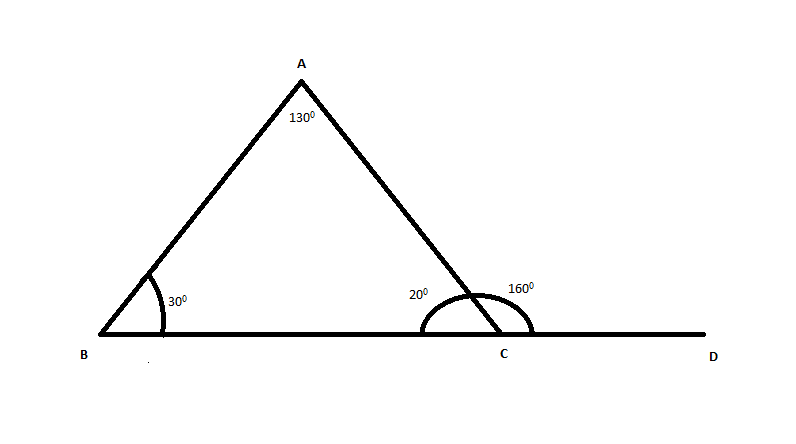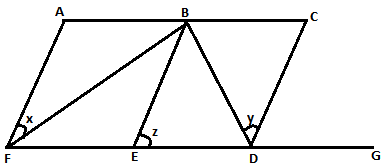7th Grade > Mathematics
LINES AND ANGLES MCQs
:
(a) Answer: 1 Mark
Reason: 1 Mark
(b) Solution: 1 Mark
(a) A triangle can have only one obtuse angle.
If we have more than one obtuse angle in a triangle, then the sum of two (obtuse) angles will exceed 180∘.
Since the sum of all angles of a triangle is 180∘.
⇒ A triangle cannot have more than one obtuse angle.
(b)
∠BCD=180∘ (Straight angle)
∴∠ACB=∠BCD−∠ACD=(180−160)∘=20∘
⇒∠BAC=180∘−(∠ABC+∠ACB)=180−(30+20)=180−50=130
∴∠BAC=130∘
:
Acute Angle: 1 Mark
Right Angle: 1 Mark
Obtuse Angle: 1 Mark
Angles are classified based on their measure as:
(i) Acute Angle: An angle that is > 0 and < 90∘ is called an acute angle.
(ii) Right Angle: An angle that is exactly equal to 90∘, is called a right angle.
(iii) Obtuse Angle: An angle that is > 90∘ and < 180∘, is called an obtuse angle.
:
(a) Conditions: 2 Marks
(b) Explanation: 1 Mark
(a) Two angles are said to be adjacent if they have:
i) Common vertex
ii) Common arm
iii) Non-common arms are on either side of the common arm
(b) If ∠1 decreases then, ∠2 will increase by the same measure, so that both the angles are still supplementary.
:
(a) Solution: 1 Mark
(b) Application of concept: 1 Mark
Correct Answer: 1 Mark
(a) There are 4 points of intersection between the parallel lines & transversal.
(b) In the above figure since the two lines are parallel and cut by a transversal, using the property of corresponding angles:
=> 2x - 60∘ = x
=> x - 60∘ = 0
=> x = 60∘
:
Each part: 2 Marks
(a) Given, a∥b and l∥m
Mark an angle 1 in the figure.
∠1=80∘ [Corresponding angles]
∠1 + ∠x= 180∘ [Since l∥m,∠1 and ∠x are cointerior angles]
⇒∠x=180∘−80∘
⇒∠x=100∘
(b) ∠5=5x+35 (Alternate angles)
45∘+∠5=180∘ (Linear pair)
∠5=180∘−45∘
=135∘
∴5x+35=135
⇒5x=135−35=100
⇒x=1005=20
:
(a) Correct answer: 1 Mark
(b) Each angle: 1 Mark
(a)
The total number of line segments is 8. The line segments are AF, AB, BF, FD, FC, CD, AC and BD.
(b) (i) ∠x and ∠55∘ are vertically opposite,
∠x = 55∘
∠x + ∠z = 180∘
55∘ + ∠y = 180∘
∠y = 180∘ – 55∘ = 125∘
∠y = ∠z (Vertically Opposite angles)
∠z = 125∘
(ii) ∠z = 40∘ (Vertically opposite angles)
∠y + ∠z = 180∘
∠y = 180∘ – 40∘ = 140∘
40∘ + ∠x + 25∘ = 180∘
65∘ + ∠x = 180∘
∠x = 180∘ – 65∘ = 115∘
:
ΔAEC and ΔDBF are equilateral, therefore angle made at each vertex is =60∘
Consider ΔAMN,
∠MAN=60∘
∠AEC=∠AMN=60∘ (Corresponding Angles as FB∥EC)
Similarly ∠ACE=∠ANM=60∘ (Corresponding Angles).
Hence all angles of ΔAMN are equal to 60∘ and is an equilateral triangle.
Consider ΔBNO, ∠FBD=60∘
∠BNO=∠ANM=60∘ (vertically Opposite Angles)
∠BON=60∘ (Angle sum property of triangle).
Hence ΔBNO is also equilateral.
Similarly, we can prove it for the remaining triangles
:
(a) Steps: 1 Mark
Proof: 1 Mark
(b) Steps: 1 Mark
Correct Answer: 1 Mark
∠1=∠2 (given)
They are also corresponding angles.
⇒l∥m...(i) (If corresponding angles are equal, then the lines are parallel)
Also, l∥BC....(ii)
From (i) and (ii):
m∥l∥BC.
⇒m∥BC.
(b) In ΔBDA, x + x + y = 180∘ (by angle sum property)
similarly, in ΔBDC, x + x + ∠BDC = 180∘
Comparing the two equations, we have ∠BDC = y.
Also, ∠BDC + ∠BDA = 180∘ (linear pair)
or, y + y = 180∘
or, y = 90∘
:
Application of theorems: 1 Mark
Steps: 1 Mark
Correct answers: 2 Marks
Given p ∥ q
125∘+e=180∘ [Linear pair]
∴e=180∘−125∘=55∘ (i)
e=f=55∘ [Vertically opposite angles]
a=f=55∘ [Alternate interior angles]
a+b=180∘ [Linear pair]
⇒55∘+b=180∘ [From eq. (i)]
⇒b=180∘−55∘=125∘
a=c=55∘ , b=d=125∘ [Vertically opposite angles]
⇒a=55∘, b=125∘
c=55∘, d=125∘, e=55∘, f=55∘.





















